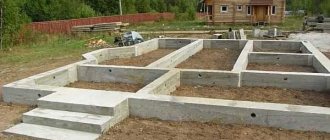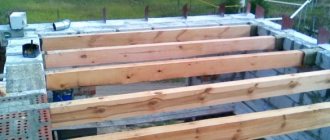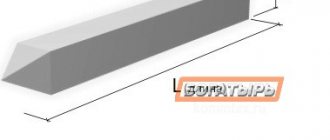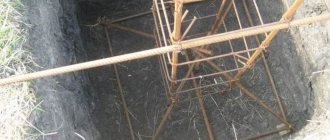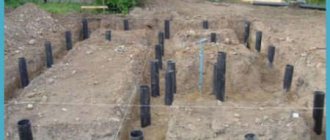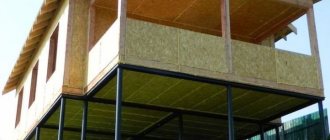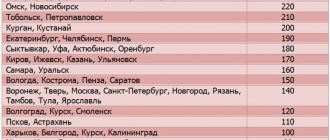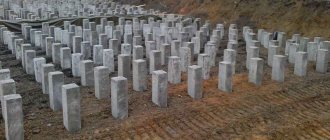Preparation for calculation
Design of bored piles
The initial data that will be needed to calculate the bearing capacity of a bored pile is obtained as a result of geological surveys and calculation of the total expected load of the building. These are mandatory stages of calculation, the implementation of which is justified by the theory of calculating the strength characteristics of bored foundations.
Indicators such as freezing depth, groundwater level, soil type and its mechanical characteristics are very important for obtaining an accurate result. Information on the depth of soil freezing is in SNiP 2.02.01-83*, the data is divided by climatic regions, presented cartographically and in the form of tables.
The calculation of the mass of a building is carried out taking into account the climatic region, the location of the building relative to the direction of the winds, the average amount of precipitation in winter, the mass of building structures and equipment. This indicator is most significant when designing a foundation - the data for this part of the calculation, as well as the diagram and calculation formulas can be found in SNiP 2.01.07-85.
Conducting geology
Pit for geological surveys
Conducting geological surveys is a responsible undertaking, and in mass production construction this is carried out by specialist geologists. In individual housing construction, independent assessment of soil conditions is often carried out. Without experience in conducting research of this level, it is very difficult to assess the real state of affairs. The work of a competent specialist largely consists of visually assessing the state of the strata.
To begin with, pits are arranged on the site - vertical excavations of rectangular or circular section, with a depth of two meters and a width sufficient for visual inspection of the base of the pit walls. The purpose of the holes is to open the soil in order to gain access to the strata hidden under the top layer of soil. Geologists measure the depth of the layers, take a soil sample from the middle of each layer, and subsequently observe the accumulation of water at the bottom of the face. Instead of holes, round wells can be installed, from which cores are removed using a special device or local samples are taken.
All received data is entered into a summary table. In addition, a soil section profile is compiled, which allows one to predict the condition of the soil at points where drilling was not carried out. When independently assessing the foundations, you should be guided by the information presented in SNiP 2.02.01-83* and GOST 25100-2011, where the relevant sections present classifications of soils with descriptions, methods for visually determining soil types and characteristics in accordance with the types.
Calculation formulas
To calculate the number of piles in the foundation, two parameters are needed - the total weight of the building and the bearing capacity of each individually..
The calculation is made using the formula.
? = m RF, where
R – design soil resistance accepted.
F – support area.
m is the coefficient of operating conditions of the pile in the ground (we assume m=1).
The calculated soil resistance is accepted for sands with any moisture level 3-4.5 kgf/cm2, 1-6 kgf/cm2, 5-6 kgf/cm2.
In practice, the calculation of the strength of a pile is determined by the grade of concrete that was used in its manufacture. The number in the concrete grade shows how much load the pile can withstand per square cm of its weight. For example, a pile made of M100 concrete with a cross section of 200x200 mm = 400 cm2 will withstand a load of 40,000 tons.
Summary data
For convenience, we will summarize the data in a general list:
Reinforcement of a bored foundation: reinforcing bars.
- With a support diameter of 150 mm, the support area will be equal to 177 cm2, the load-bearing capacity of the pile is assumed to be 1062 kg.
- With a support diameter of 200 mm, the support area will be equal to 314 cm2, the load-bearing capacity of the pile is assumed to be 1884 kg.
- With a support diameter of 250 mm, the support area will be equal to 491 cm2, the load-bearing capacity of the pile is assumed to be 2946 kg.
- With a support diameter of 300 mm, the support area will be equal to 707 cm2, the load-bearing capacity of the pile is assumed to be 4242 kg.
- With a support diameter of 400 mm, the support area will be equal to 1256 cm2, the load-bearing capacity of the pile is assumed to be 7536 kg.
- With a support diameter of 500 mm, the support area will be equal to 1963 cm2, the load-bearing capacity of the pile is assumed to be 11775 kg.
Data on the diameter of the pile reinforcement is given in the section “Brief information on the technology for constructing a bored foundation.”
And its consumption can be calculated as follows:
- A 150 mm pile is a frame of 3 rods, with a ribbed profile reinforcement consumption of 6 m, a smooth reinforcement – 0.75 m.
- 200 mm - frame of 4 rods, with a consumption of ribbed profile reinforcement 8 m, smooth - 1 m.
- 250 mm - frame of 4 rods, with a consumption of ribbed profile reinforcement 8 m, smooth - 1.26 m.
- 300 mm - frame of 6 rods, with a consumption of ribbed profile reinforcement 12 m, smooth - 1.51 m.
- 400 mm - frame of 8 rods, with a consumption of ribbed profile reinforcement of 16 m, smooth - 2.01 m.
- From 500 mm - a frame of 10 rods, with a consumption of ribbed profile reinforcement of 20 m, smooth - 2.05 m.
Calculation of the total number of foundation piles
Calculation of piles: number of piles, dimensions.
Taking into account the total weight of the house and its load on the bored foundation, the required number of piles is calculated. It is proportional to the weight of the house, which depends on what material it will be made of. If it is aerated concrete, the pressure will be lighter; if it is brick, then its weight will be much higher. The greater the weight of the house, the greater the load on the foundation, the more piles will need to be installed. Accordingly, the installation pile step will decrease. Here it is worth remembering one important point that will help to avoid errors in calculations. There is a limitation on the minimum distance between the axes of the piles. It should not exceed three diameters of the pile. Failure to maintain this distance will have the opposite result - it will reduce their load-bearing capacity, thereby weakening the foundation of the house.
For example, with a pile diameter of 500 mm, which is most often used in the construction of a brick house with a bored foundation, the minimum distance between the axes should be more than 150 cm.
In this way and using these recommendations, you can independently calculate the bored foundation for your brick house. However, if you have doubts about whether you have chosen the right foundation, or about the correctness of the calculation, then you should contact specialists who can more accurately determine the type of soil and its characteristics, and also check your calculations.
Characteristic advantages and disadvantages of installing driven piles
This type of foundation for a building has advantageous and undeniable differences from other foundations in terms of parameters: This is what round driven piles look like
- there is no need to carry out a large amount of excavation work, and it is easy to install;
- foundation piles can be driven into any weak soil, except greasy rocks;
- the material for making piles can be selected based on the construction budget, building parameters and soil type;
- holds a large mass of the structure well, used in the construction of high-rise buildings with a large number of floors;
- the service life of this foundation is 100 years;
- the possibility of increasing strength by installing a strip foundation made of piles;
- a pile foundation for a brick house is not afraid of temperature changes, moisture-resistant, non-flammable and resistant to environmental influences;
- It is easy to transport and store reinforced concrete piles.
But like any material and method of arranging the foundations of a house, this type of foundation has a number of disadvantages that are worth talking about:
- First of all, you will have to plan the basement and provide ways to arrange it.
- If the site is dominated by planting soils that are prone to swelling, then the pile-driven foundation may not be stable enough.
- If the soil on your site is as described above, then do not despair and buy another land - there is a way out of this situation. The pile-driven foundation can be strengthened, for example, by installing a monolithic slab on supports, or by installing a pile-strip foundation.
Important! If you decide to arrange a grillage, then there should be a gap between the soil and the tape, which after installation is filled with fine crushed stone or sand. This is done so that during winter heaving the soil cannot affect the grillage tape. Diagram with the dimensions of a pile foundation with a grillage Of course, this type of foundation has disadvantages, but there are few of them, and at the same time you can always bypass them and find a way to eliminate them There is one more important point - before purchasing material for the manufacture of a pile-driving foundation, you need to carefully study the documents, which should contain information about the manufacturer of the piles, the material used in their manufacture, the date of production, and the batch number. In addition, the seller must provide you with a certificate of conformity for this product.
If there are no documents, then you should refuse the purchase. Carefully inspect the material; the surface of the piles should be flat and smooth without visible damage or unwanted inclusions. For example, microcracks can be detected if one of the sides is wet. A drawing with the dimensions of a foundation device using driven piles. When dry, darkened stripes will appear on the surface - this indicates that the material is of poor quality. It is also worth considering the types of piles, as they can be made of different materials
In addition, the seller must provide you with a certificate of conformity for this product. If there are no documents, then you should refuse the purchase. Carefully inspect the material; the surface of the piles should be flat and smooth without visible damage or unwanted inclusions. For example, microcracks can be detected if one of the sides is wet. A drawing with the dimensions of a foundation device using driven piles. When dry, darkened stripes will appear on the surface - this indicates that the material is of poor quality. It is also worth considering the types of piles, since they can be made of different materials.
Methods for determining the bearing capacity of a pile
There are several methods for making such calculations. These include:
- Calculation method. It is not highly effective, but is used quite often, since, unlike others, it is quite simple.
- Test static loads. An extremely effective technique, but it requires a lot of time and effort. Quite often used by professionals.
- Dynamic test. It is carried out by several hammer blows on the installed piles, after which the settlement is fixed. The advantage of this method is that it can be used directly on the construction site, but unlike the previous method, it is not as effective.
- Probing. This method involves a combination of static and dynamic methods. It is produced by recording load-bearing capacity data on the base surface from pre-installed special sensors. The equipment is quite expensive, so such calculations are often performed only by specialists.
The calculation method is often used by ordinary people, since it does not require special equipment or a lot of experience. You just need to collect certain data that will be useful for calculations. Other techniques can also be used, but their implementation will require knowledge and equipment, which beginners in the construction craft often do not have.
To increase your knowledge on the topic of calculating the bearing capacity of piles, it is recommended to watch the following video.
As the number of pillars for the base increases, its strength also increases.
Why do you need to use a pile foundation calculation?
Sketch indicating the parameters required for the calculation
Considering that piles in foundations are ordinary support points that are responsible for uniformly transferring the entire volume of loads from the building and the soil through the base to strong layers of soil, they are selected only after calculating the grillage. For example, the maximum permissible dimensions, thickness, design, and other parameters.
Also, the choice of diameter of piles used in construction is influenced by factors related to the type of soil, which are also taken into account in the calculations. Calculation of a pile foundation is needed for some conveniences:
- It will be possible to make an extended project for the pile foundation, taking into account the installation locations of the supports, as well as the distance between them.
- You can significantly save on the volume of building materials used by choosing the optimal type of support.
- The calculation involves choosing the optimal support diameter, its length and dimensions, as well as selecting the type of sole.
You can also immediately determine whether screw piles are suitable for a given type of construction or whether cast-in-place or other types of piles should be used.
Calculation example
To better understand the principle of calculations, it is worth studying an example calculation. Here we are considering a one-story brick building with a hip roof made of metal tiles. The building is supposed to have two floors. Both are made of reinforced concrete with a thickness of 220 mm. The dimensions of the house are 6 by 9 meters. The thickness of the walls is 380 mm. Floor height - 3.15 m (from floor to ceiling - 2.8 m), total length of internal partitions - 10 m. There are no internal walls. A refractory sandy loam with a porosity of 0.5 was found on the site. The depth of this sandy loam is 3.1 m. From here we find from the tables: R = 46 tons/sq.m., fin = 1.2 tons/sq.m. (for calculations, the average depth is assumed to be 1 m). Snow load is taken according to Moscow values.
We collect loads in the form of a table. At the same time, do not forget about the reliability coefficients.
| Type of load | Calculation |
| Brick walls | wall perimeter = 6+6+9+9 = 30 m; wall area = 30 m*3m = 90 m2; wall mass = (90 m2* 684)*1.2 = 73872 kg |
| Partitions made of plasterboard, not insulated, 2.8 m high | 10m*2.8*27.2kg*1.2 = 913.92 kg |
| Flooring made of reinforced concrete slabs 220 mm thick, 2 pcs. | 2pcs*6m*9m*500 kg/m2 *1.3 = 70200 kg |
| Roof | 6 m*9 m*60 kg*1.2 /сos30ᵒ (roof slope) = 4470 kg |
| Load from furniture and people on 2 floors | 2*6m*9m*150kg*1.2 = 19440 kg |
| Snow | 6m*9m*180kg*1.4/cos30° = 15640 kg |
| TOTAL: | 184535.92 kg ≈ 184536 kg |
We preliminarily designate a grillage 40 cm wide and 50 cm high. The length of the pile is 3000 mm, D section = 500 mm. We use an approximate pile spacing of 1500 mm. To calculate the total number of supports, you need to divide 30 m (length of the grillage) by 1.5 m (pile pitch) and add 1 pc. If necessary, the value is rounded down to the nearest whole number. We get 21 pieces.
Area of one pile = 3.14 • 0.52/4 = 0.196 sq.m., perimeter = 2 • 3.14 • 0.5 = 3.14 m.
Let's find the mass of the grillage: 0.4 m • 0.5 m • 30 m • 2500 kg/cubic meter • 1.3 = 19500 kg.
Let's find the mass of the piles: 21 • 3 m • 0.196 sq.m. • 2500 kg/cub.m. • 1.3 = 40131 kg.
Let's find the mass of the entire building: the sum from the table + the mass of the piles + the mass of the grillage = 244167 kg or 244 tons.
For the calculation, the load per linear meter of the grillage will be required = Q = 244 t/30 m = 8.1 t/m.
Calculation of piles. Example
We find the permissible load on each element using the formula indicated earlier: P = (0.7 • 46 tons/sq.m. • 0.196 sq.m.) + (3.14 m • 0.8 • 1.2 tons/sq.m. m. • 3 m) = 15.35 t. Pile pitch is taken equal to P/Q = 15.35/8.1 = 1.89 m. Round up to 1.9 m. If the pitch is too large or small, you need to check several more options, while changing the length and diameter of the foundations.
For frames, rods D = 14 mm and clamps D = 8 mm are used.
Grillage calculation. Example
It is necessary to calculate the mass of the building without taking into account the piles. Hence M = 204 tons. The width of the tape is assumed to be M / (L • R) = 204 / (30 • 75) = 0.09 m. Such a grillage cannot be used. The overhang of the walls of a brick building from the foundation should not exceed 4 cm. The width is set to 400 mm. The height remains at 500 mm.
Reinforcement of the pile foundation grillage:
- Working 0.1%*0.4*0.5 = 0.0002 sq.m. = 2 sq. cm. Here, 4 rods with a diameter of 8 mm will be sufficient, but according to regulatory requirements we use the minimum possible diameter of 12 mm;
- Horizontal clamps - 6 mm;
- Vertical clamps - 6 mm.
The calculations will take a certain amount of time to complete. But with their help you can save money and time during the construction process.
You can also calculate the foundation using an online calculator. Just click on the link Calculation of a columnar foundation and follow the instructions.
Total load calculation
Collecting loads allows you to determine the mass of the building, which means the force with which the building will act on the foundation as a whole and on its individual elements. There are two types of loads acting on a supporting structure - temporary and permanent. Dead loads include:
- A lot of wall structures;
- Total mass of floors;
- A lot of roofing structures;
- Mass of equipment and payload.
You can calculate the mass of structures by determining the volume of the structures and multiplying it by the density of the material used. An example of calculating the mass for a one-story building with reinforced concrete floors, a roof made of ceramic tiles and walls of 600 mm made of reinforced concrete, dimensions 10 by 10 meters in plan, floor height 2 meters:
- We calculate the volume of the walls by multiplying the cross-sectional area of the wall by the perimeter. We get V walls = 20 ∙ 2 ∙ 0.6 = 24 m3. We multiply the resulting value by the density of heavy concrete, which is equal to 2500 kg/cm3. The final mass of wall structures is multiplied by the reliability coefficient, for concrete equal to k = 1.1. We get the mass M of the wall = 66 tons.
- Similarly, we calculate the volume of floors (basement and attic), the mass of which with a thickness of 250 mm will be equal to Mpc = 137.5 tons, taking into account a similar reliability factor.
- We calculate the mass of roof structures. Roofing weight for 1 m2 of metal tiles is 65 kg, soft roofing is 75 kg, ceramic tiles are 125 kg. The area of a gable roof for a building with such a perimeter will be approximately 140 m2, which means the mass of the structures will be Mkr = 17.5 tons.
- The total size of the permanent load will be equal to Mpost = 221 t.
Reliability factors for various materials are found in the seventh section of SP 20.13330.2011. When calculating, the mass of partitions, façade cladding materials and insulation should be taken into account. The volume occupied by window and door openings is not subtracted from the total volume for ease of calculation, since it constitutes an insignificant part of the total mass.
Calculation of live loads
Grillage on screw piles
Live loads are calculated in accordance with the climatic region and the instructions of the set of rules “Loads and Impacts”. Temporary loads include snow and payloads. The useful load for residential buildings is 150 kg per 1 m2 of flooring, which means the total useful weight will be equal to Mpol = 15 tons.
The weight of the equipment that is supposed to be installed in the building is also summed up in this indicator. For a certain type of equipment, a reliability factor is applied, located in the above set of rules.
There are various types of special loads that also need to be taken into account in the design. These are seismic, vibration, explosive and others.
Snow load is determined by the formula:
where ce is the snow drift coefficient equal to 0.85;
ct – thermal coefficient equal to 0.8;
m – transition coefficient, for buildings with a plan less than 100 m, adopted according to Table D of the above SP;
St – weight of snow cover per 1 m2. Accepted according to table 10.1, depending on the snow area.
The indicators of temporary loads are summed up with permanent ones and a quantitative indicator of the total load of the building on the foundation is obtained. This number is used to calculate the load on one pile column and compare the ultimate strength. For the convenience of calculation and clarity of the example, we will accept temporary loads Mvr = 29 t, which in sum with the constant ones will give Mtot = 250 t.
Watch the video on how to correctly calculate the load on the base.
How to calculate the number of piles for a foundation
Correct calculation of the number of piles used requires preliminary geodetic survey. First of all, it is necessary to calculate the level of soil freezing in winter, taking into account that this indicator differs in different regions. To install the pile firmly, its lower end must be below this level.
It is also necessary to find out the degree of density of the soil layers. The higher the density, the shallower the depth of the pile should be laid at the design stage. For example, for semi-rocky and large-block rocks it will be minimal (but not less than 0.5 meters), and for sandy and clayey soils it will have to go as deep as possible.
1. Calculation of the potential ultimate load on piles
Before you start calculating the number of piles for the foundation, you should find out the bearing capacity of an individual pile. The general form of the formula is as follows:
In this case, W is the desired actual load-bearing force, Q is the calculated value of the load-bearing force, calculated for an individual pile based on the material, dimensions and characteristics of the soil; k is an additional “reliability factor” that expands the operational reserve of the foundation.
2. Calculation of the design load on piles
Next, we need to find the parameter Q, without which the calculation of a pile foundation is impossible. The design load is determined by the formula:
Where S is equal to the cross-sectional area of the pile blades, and Ro is an indicator of soil resistance at the depth of the blades. Soil resistance can be taken from the prepared table:
table 2
As for the “reliability coefficient” of a conditional foundation, its value can vary between 1.2-1.7. It is logical that the lower the coefficient, the lower the cost of the foundation at the design stage, since the use of a large number of piles will not be required to achieve a given value of the bearing force. To reduce the coefficient, a high-quality and reliable analysis of the soil at the construction site should be carried out, involving specialists.
3. Calculation of the load from the building structure
At the final stage of designing a pile foundation, the number of piles is calculated. To do this, you will need to summarize all the structural elements of the building: from the main walls and ceilings, to the rafter system and roof. It is quite difficult to accurately calculate all components, so we recommend using one of the specialized calculators. And also operational loads are entered into the calculation calculator, including interior items, furniture, household appliances and even people living in the house.
4. Calculation of the required number of piles
Before calculating the number of piles involved, we need to obtain two values at the previous stages: the total mass of the building (M) and the load-bearing capacity of the pile (W) multiplied by the “reliability factor”. The value of the bearing capacity can be taken from Table 1. So, if the mass is 58 tons, and the adjusted bearing capacity of the SVS-108 pile is 3.9 tons, then:
As the calculation example showed, for a house weighing 58 tons, 15 piles of the SBC-180 grade will be required. It should be noted that this value is approximate and does not take into account the rules for the exact distribution of piles according to SNiP:
- The first should be installed at the intersection points of load-bearing structures;
- The rest are mounted evenly between the designated corners;
- The minimum distance between individual piles is 3 meters;
5. Installation depth of piles and distance between them
The basic value of the installation depth of the pile is calculated based on the depth of soil freezing in a particular region, plus 25 centimeters. And also before calculating the pile foundation, you need to find out:
- Pile strength level by material and design;
- Bearing capacity of the soil;
- Calculate the settlement of the pile foundation that occurs over time under the load of the building;
- Additional parameters (temperature conditions throughout the year, precipitation volume, wind loads, etc.).
Design calculation
The frame of a bored foundation is regulated by GOST.
To perform the calculation, it is necessary to take into account the bearing capacity of each individual pile and their number. It is clear that the load-bearing capacity directly depends on its dimensions. Moreover, as we will see during the calculation, a very small difference in the diameter of the pile significantly increases its load-bearing capacity. For example, with d=300 mm it will withstand a load of 1700 kg, and if you increase its diameter by 200 mm, then its load-bearing capacity will increase sharply and it will be able to withstand a weight of up to 5000 kg.
When constructing a bored foundation on your own, it is very difficult to understand whether the level of soil incompressibility has been reached during drilling. Therefore, experts advise, even after calculations, to drill to a depth of one and a half to two meters to be on the safe side. This depth ensures that the freezing depth remains significantly higher, the groundwater level has already been passed, and the bearing capacity of the soil at such a depth is quite large and will certainly be greater than the calculated one by a large margin (approximately 6 kg/cm2)
Another point directly related to calculations is the choice of drill size. Modern equipment makes it possible to drill very deep wells of different diameters from 15 to 40 cm. And the so-called foundation drills allow, with a very small drilling diameter, for example 20 mm, upon reaching the bottom, the diameter of the base can be doubled or even tripled. This expansion provides bearing area for the pile and increases its ability to resist buckling.
When making calculations, we are guided by the regulatory document - Code of Practice SP 24.13330.2011 Pile foundation. Updated version of SNiP 2.02.03-85.
How not to make mistakes without experience
With soil group
Pile foundation is a good choice for clay soils
The basis for calculating and determining the feasibility of constructing a pile foundation, as well as any other foundation, is the identification of the type of soil.
Soils can be divided into several groups:
- Stony (rocky) soil in itself can provide a reliable foundation for building a house, so there is no point in building a pile foundation on it;
- On sandy soils (as well as on “cartilaginous” soils - a mixture of sand, gravel, clay) there is also no special need to install piles - it is best to install shallow strip foundations on them, naturally, below the freezing depth;
- On loams and sandy loams, evenly folded, it is quite possible to build a house on a strip foundation;
- Peat bogs allow the construction of only light buildings on a slab foundation. Watch the video on how not to make a mistake with the type of foundation.
With number of piles
In order to use the rather complex calculations described above, simple rules have been developed for selecting the number of piles in accordance with the distribution of support points along the perimeter of the building:
- Under frame-panel and wooden houses, the interval between piles should not exceed 3 m;
- For lightweight concrete structures, the distance between buried supports should be no more than 2 m.
The simplest and most understandable is the following example.
A house plan is drawn to scale on a sheet of paper. At the corners and intersections of the walls, points are marked where the piles should be installed first. Next, the rules for placing supports described just above apply, depending on the material from which the building is being erected. Watch the video on how to calculate the number of piles.
No matter what materials the house is built from, no matter what size and design features it has, the calculation of the pile foundation as the supporting structure of the entire structure can be called the most important nuance of successful construction.
We will help you calculate a pile field made of bored piles
Buy Larsen sheet piling Turnkey bored foundation Installation of bored piles Installation of strip foundation with bored piles
The foundation on bored piles is one of the most versatile in terms of load. The permissible load depends on the parameters of the piles themselves and the pile field. How is the calculation of bored piles performed?
Determining the size of the piles
If peat or floating soils are discovered when drilling a well, then you need to go deeper
For construction sites with stable, dense soil, supports 2.5 m long are suitable. On a site with complex terrain, height differences must be taken into account. On uneven areas we use piles of different lengths, which depend on the height of the area.
When constructing on unstable soils, the length of the pile should reach the layer of dense soil. We find the location of stable soil using test drilling. We insert the drill into the soil, remove it at short intervals and look at the appearance of the soil on the knife.
If we find a peat bog, quicksand, we drill the wet soil to a sandy or clay layer. After finding lumps of sand and clay on the drill, we measure the depth of the hole using a stone lowered on a rope.
Selection of concrete composition. Secrets of the professionals
For those who have decided not only to pour concrete themselves, but also to prepare it, we will consider calculating the components for 1 cube of the most popular brands.
Attention! I would like to immediately make a reservation about the auxiliary methods for preparing the working solution. The dosage of 1 cube should come strictly from GOST materials, and not from improvised materials. For example, today it is widely practiced to add detergents to improve the workability of the solution. Yes, the substances contained in soap dishes increase plasticity. But foaming also increases, which reduces the density and, accordingly, the strength of concrete. Indicators of crack resistance, frost resistance and durability in general also decrease. All this is the result of the activity of carbonates and phosphates, the amount of which is in excess, especially in cheap detergents.
- Below we will consider how much material is needed for 1 m3 of solution, without taking into account plasticizers, since different types and manufacturers recommend their own dosage. But basically, it is calculated based on the amount of cement.
- The indicated value must simply be multiplied by the amount of cement and the required volume of the additive will be obtained. At the same time, the mass of such a unit of concrete will not change due to the use of a plasticizer.
- For the foundation, depending on the characteristics of the construction site and future construction, a mixture of grades M200, M250, M300 is used.
- For floor screeding, M200 is sufficient for reinforcement; M300 is rarely used in industrial premises. And as a filler for wall formwork, commercial cellular concrete is used - foam concrete or polystyrene foam concrete, which is best purchased ready-made from professional manufacturers.
- The table shows the selection of the composition of concrete grades in parts. The ratio of components depends on the brand of cement used.
Testing piles for pull-out loads
To determine the pull-out loads, static tests of screw piles are carried out. In the presence of sandy soil layers, measurements are carried out after 3 days, and for clayey ones - only after 6 days. For bored piles, testing work should be carried out only after the concrete has reached strength, determined from the data of samples taken during the laying of the support.
Indentation tests
Testing screw piles using the static method
The list of basic tests for pressing supports under a house includes the following stages:
- Uniform load.
- Differentiated load.
- Differentiated load performed according to the hysteresis dependence.
The magnitude of the load is determined by the need to determine a given level of measurement accuracy. Typically, for a uniform load it is 0.07-0.1 of the total calculated load, and for a differentiated load it is 0.2-0.4 for the initial stage and 0.07-0.1 for subsequent ones.
The transition between degrees of loading is carried out only after determining the complete stop of shrinkage. The criterion is the absence of changes during the last 2 hours of observation. The exception to this rule is sandy and clayey soils, where there is a need for accelerated testing. In this case, the conclusion about stabilization of the pile is made within an hour in the absence of displacements of less than 0.1 mm.
At each loading stage, the readings of the measuring instruments on the vertical displacement of the pile are recorded. Measurement intervals last from 15 to 30 minutes. The total number of intervals must be at least three. If an odd number of stages is selected, then the load on the first is taken equal to the value of all subsequent ones. After this, a time dependence on the vertical displacement is constructed, and then compared with the standard value SP 22.13330.2011. The limit value is considered to be one that corresponds to 0.1 of the standard load.
Watch a video of indentation testing of supports.
Pull-out tests
Tests for pulling out screw piles under a house with a diameter of 108 mm are determined by soil parameters, as well as the magnitude of the expected loads. Includes the following types of loading:
- Increasing step load while waiting to reach a stationary state in the pile position.
- Pulsating stepwise impact with increasing load in several stages: 1.25, 2.5 or 5 ms. The essence is to carry out loading at each stage from zero to maximum, and then completely remove it without waiting for it to reach a stationary state. Changing the steps is carried out only after the vertical displacement of the support has stabilized compared to the previous one.
- Alternating load. The support is subject to repeated loading of the same magnitude for pulling out and indentation, which change their sign when passing through an unloaded point.
- Continuously increasing load - a constant pulling force acts on the pile. When changing the load value, do not wait for complete stabilization, since it is quite enough to achieve a certain conditional value. The maximum load value is considered to be when the upward movement of the support does not exceed 0.1 of its diameter. For variable and pulsating loads, the change in position should not be more than 0.05 of the pile diameter.
Bored pile designs
When creating a pile foundation of this type, pile structures are made and used from monolithic concrete
When creating a pile foundation of this type, pile structures are made and used from monolithic concrete, combined, prefabricated (from reinforced concrete). The latter are often made with a widened heel - an option indicated for construction in problematic soils, where the main composition is clay and loam. Widening the heel makes it possible to increase the load-bearing capacity of the pile element, but this technological technique is not used in rocky soils.
When determining the types of bored piles, it is necessary to be guided by GOST 19804.2-79; GOST 10060.0-95. The most commonly used are bored, secant and drilled tangential piles. Drilling foundations also include downhole-type structures: wells filled with crushed stone filling with layer-by-layer compaction, supports with a widened heel, for the manufacture of which blasting is used, and hollow supports made using a core.
Bored piles
These are structures, including reinforced concrete ones, which have become widespread due to the ease of arrangement
These are structures, including reinforced concrete ones, which have become widespread due to their simplicity of arrangement, the possibility of using them to strengthen an existing foundation and to build foundations in a limited space. The advantage is the minimal dynamic load on neighboring buildings, the absence of destructive effects on highways and underground communications. In addition, the foundation manufacturing technology allows the facility to operate as usual during restoration work.
Wells are made using drilling devices; when the required depth is reached, the drill is removed and the well is reinforced with a pre-fabricated frame, after which it is filled with a mixture of concrete. The production of bored piles can be carried out using the following technologies:
- Using casing pipe;
- Using a clay mash;
- By using a through screw;
- Using a double rotator;
- By compacting the soil.
Advantages of drilled piles:
- Possibility of production on site;
- Long service life;
- Relative low cost of the project;
- High bearing capacity of the foundation;
- Variability of thickness;
- Minimum requirements for the use of heavy equipment (sometimes you can do without it altogether);
- Wide range of applications.
However, there are also disadvantages:
- Compared to strip and slab foundations, the load-bearing capacity is low;
- Increased labor costs;
- The difficulty of making piles on water-saturated soils.
Brown secant piles
Brown secant elements are mounted in increments of “zero”, that is, they represent a solid wall of structural bodies
These are structures whose installation technology replicates bored pile elements. The difference is that the secant elements are mounted in increments of “zero”, that is, they represent a solid wall of structural bodies, which serves to provide a complete support for the soil. They are used for the construction of underground parking lots, tunnels, and passages. Construction according to SNiP 2.02.01-83 of this type is permitted at shallow depths - no more than 30 meters.
Drilled tangential piles
This type of foundation is used in case of vertical and horizontal load on elements from nearby buildings
This type of foundation is used in the case of vertical and horizontal loads on elements from nearby buildings and groundwater. As a rule, this method is used for construction in limited space, as well as for fencing very deep pits, for cutting embankments in soils containing solid coarse inclusions.
The advantages of the technology are the following:
- Ability to carry out work in densely built-up conditions;
- There is no need to arrange additional drainage or drainage;
- Making bored tangential piles is not difficult, both in terms of labor costs and quickly in terms of time.
Bored foundation: calculation, design and others
We work in Moscow and other regions of the Russian Federation. We offer installation of bored piles of any type:
- pile foundations;
- secant and drilled tangential piles for any purpose - foundations, fences, walls in the ground;
- drilling injection for repairing and strengthening foundations and retaining walls;
- TISE foundations;
- grillages.
Completed projects that we are proud of
Moscow, bridge support
Photo report on the installation of piles by specialists of PSK Osnovaniye i Foundations LLC
More details
Tver, Pig breeding complex
Installation of drilled injection piles during the construction of a pig-breeding complex
More details
Zhukovsky, Moscow region
Photo report of the installation of sheet piling during the construction of a residential building
More details
Photo report of the installation of a pit fencing during the construction of a multi-storey building in Mytishchi
More details
Moscow, Bersenevskaya embankment
Photo report of the installation of secant piles during the construction of a concrete foreshaft in Moscow
More details
Moscow, Dmitrovskoe highway
Photo report of the installation of bored piles during the reconstruction of a traffic intersection
More details
View our other projects
Our Hyundai R330LC excavator with OMS OVR 80 S vibratory loader at the site
Vibration immersion of pipes PSK Osnovaniye i Foundations LLC
Work on removing pipes using a vibrating hammer by specialists from PSK Osnovaniya i Foundations LLC
Vibration immersion of pipes PSK Osnovaniye i Foundations LLC
Vibration immersion of pipes PSK Osnovaniye i Foundations LLC
Vibration immersion of pipes PSK Osnovaniye i Foundations LLC
We also carry out design, calculation and construction of other types of foundations - strip, slab, columnar, pile-tape. We carry out all turnkey work, starting with preliminary:
- geological/hydrogeological research, field and office;
- soil testing, pile driving;
- assessment of the condition of old structures, a set of strengthening measures;
- dismantling old foundations, preparing the construction site;
- design, calculation, surveying;
- installation of fencing of any type - bored, sheet piling;
- restoration of old foundations, ceilings, load-bearing walls.
